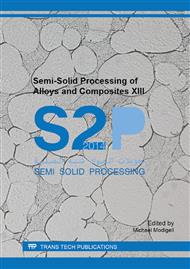p.227
p.235
p.241
p.247
p.253
p.259
p.265
p.274
p.281
Study on Refining Mechanism of Primary Si in Semi-Solid Al-25%Si Alloy Slurry Prepared by Rotating-Rod Induced Nucleation
Abstract:
In this paper, a new method for preparing semi-solid Al-25%Si alloy slurry named as Rotating-Rod Induced Nucleation (RRIN) was adopted. In this method, liquid metal (velocity 0.66 kg/s) flew toward a vertical stainless steel rod (45 mm in diameter) which was self-revolving on its axis. Molten alloy was spread around the rod surface under the effect of rotating, which caused supercooling and induced nucleation of primary Si in the molten metal. After spread around the rod, molten alloy flew off the rod and down to a graphite crucible. The influence of rotating speed on the microstructures in the semi-solid slurry was studied. The refining mechanism of primary Si was also analyzed according to the change of the spreading state, the number of primary Si particles (PSPs) in per unit area (N), and the distribution of PSPs size under a series of different rotating speeds (from 100 r/min to 1000 r/min, and at intervals of 100 r/min). The results showed that, under the lower rotating speeds such as 100 and 200 r/min, the molten alloy flew downward along the rod. With the rotating speed increasing, a molten alloy film around the rod was formed under the effect of the tangential force caused by the rotating rod, and the film thickness thinning, the spreading area and the N was increased. The uniform supercooling in the whole molten metal film was obtained under the condition of higher rotating speeds such as 500 and 600 r/min, which promoted nucleation of the PSPs significantly. It is called Rotating-Rod Induced Nucleation (RRIN). After spreading around the rod during short time, the molten metal film was thrown away the rod rapidly under the effect of centrifugal force, which prevented further supercooling and growth of PSPs. Under the condition of too higher rotating speed of the rod such as up to 700 r/min, the molten melt flew off from the rod apparently before spreading around the rod surface, molten metal film as mentioned above was destroyed, RRIN was weakened. The microstructure with fine PSPs (27 μm) was distributed uniformly in the semi-solid slab obtained under the condition of rotating speed of 600 r/min and pouring temperature of 785 °C in this experiment. Keyword: high silicon aluminum alloy; Rotating-Rod Induced Nucleation; Si phase; refinement.
Info:
Periodical:
Pages:
253-258
Citation:
Online since:
September 2014
Authors:
Price:
Сopyright:
© 2015 Trans Tech Publications Ltd. All Rights Reserved
Share:
Citation:


